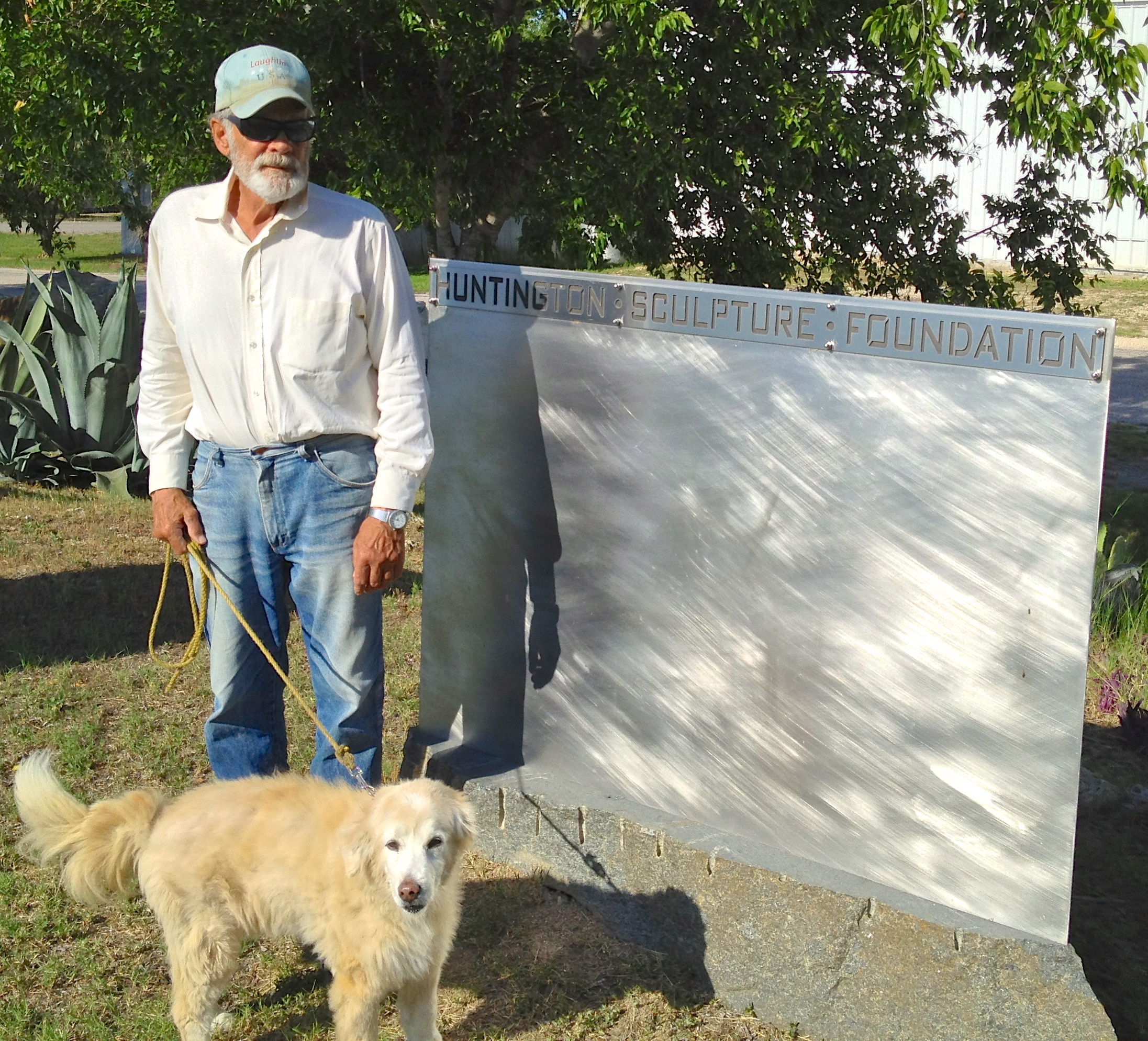Recently, I visited with Jim Huntington in his apartment at the rear of his studio in Coupland. We were joined by his dog, Cheyenne. I was impressed with the simplicity of his life. He has the basics but not much else. As we got into conversation, I learned that he doesn’t mince words. He says what he thinks about things and he doesn’t worry much about whether or not anyone dislikes what he has to say. He is sensitive to others’ feelings in certain areas but when it comes to politics . . . well, let’s just say that political correctness has no sway over him.
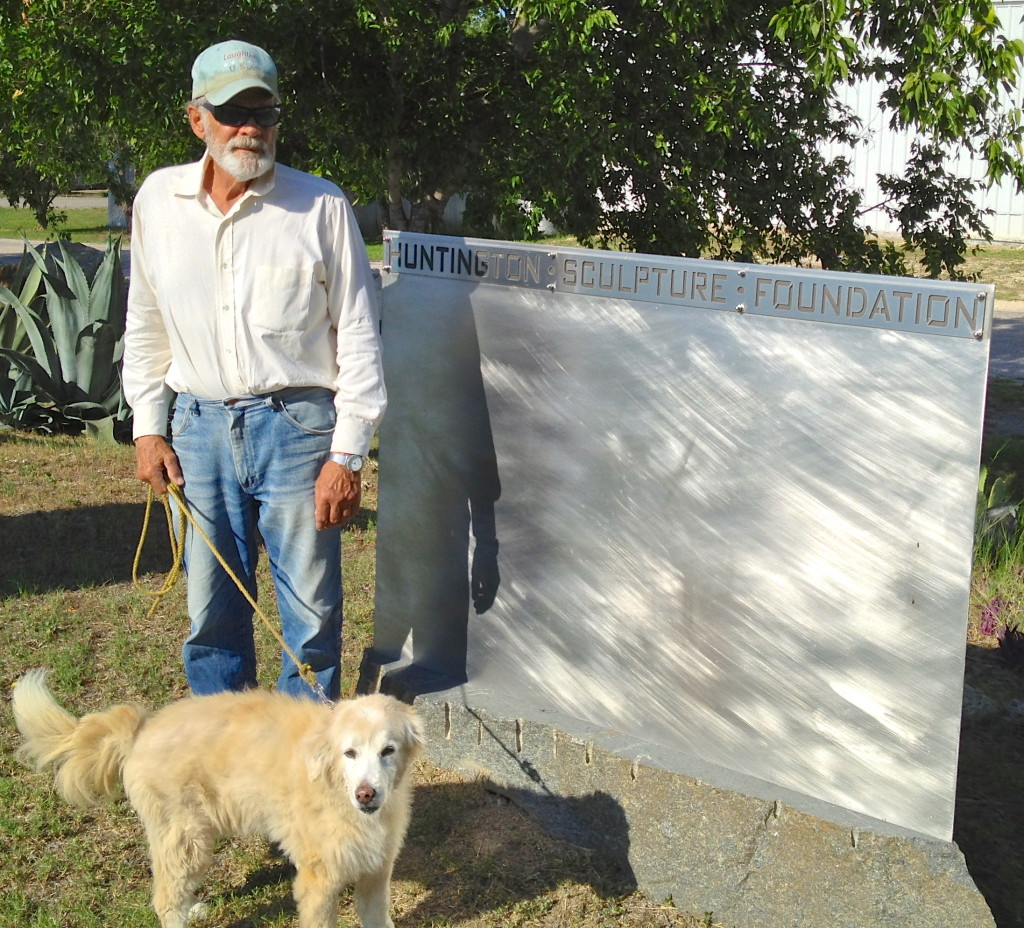
Jim is a sculptor. We discussed a recent piece called “…To Be Secure in Their Persons, Houses…,” which you should recognize as being from the Fourth Amendment of the Constitution and part of the Bill of Rights. Despite my assumption to the contrary, Jim said, “Politics is not an integral part of my work, since it is neither polemical or narrative and is only apparent in some title references.” I commented on the footer on his emails, which says, “In Memoriam: U.S. Constitution BORN 1787. DIED 2012.” He said, “This ‘signature’ on my emails was a response to Justice Roberts’ contorted, perverse ruling on 0bamacare, which was probably the worst ruling in SCOTUS history, so blatantly unconstitutional that a child could figure that out.”
Jim is not too happy about the lack of reaction on the part of many citizens to the systematic destruction of our civil rights and the Constitution. He said, “They want free shit rather than freedom.” He went on to say, “The cartoonists are doing the job the mainstream media hacks will not do. Michael Ramirez, Lisa Benson and many others have continually skewered the alien usurper with aplomb and incisive visual wit.” I’m pretty sure he wasn’t talking about an extra-terrestrial usurper.
Moving on to how he came to be in Coupland, Jim said he had been working in New York City but that it was becoming untenable. Taxes were too high and he didn’t feel that he fit in anymore. He sold his building in Williamsburg, Brooklyn for about $250,000 in 1994. It is worth $3 million now. He initially looked in Austin but spread out and found Coupland by accident.
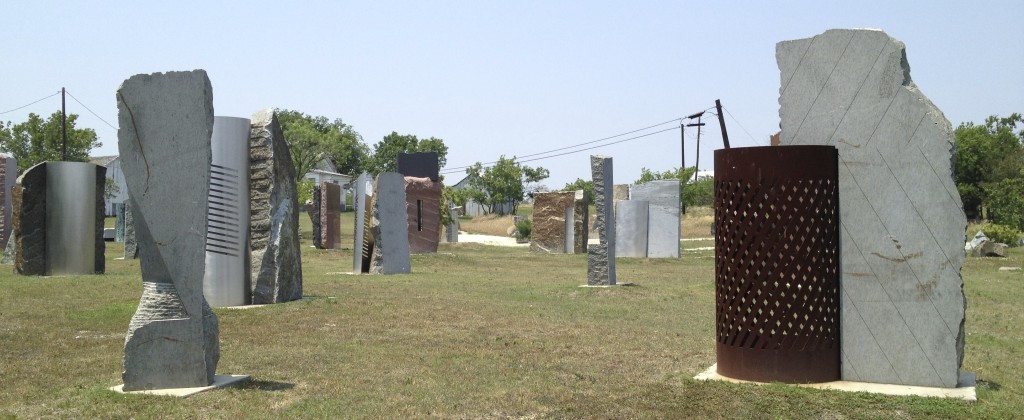 Regarding life in Coupland, Jim says he likes the attitude of the Coupland community in that they like to live and let live. He is the president of the Coupland Water Supply Corporation, which, despite its name, is all about wastewater. He feels that he should be involved and give back to the community, since he never served in the military, but he says he is too claustrophobic to be a part of the volunteer fire department.
Regarding life in Coupland, Jim says he likes the attitude of the Coupland community in that they like to live and let live. He is the president of the Coupland Water Supply Corporation, which, despite its name, is all about wastewater. He feels that he should be involved and give back to the community, since he never served in the military, but he says he is too claustrophobic to be a part of the volunteer fire department.
He eventually set up a tax-free foundation (Huntington Sculpture Foundation) as a way to preserve his art. Everything is for sale and eventually, after he passes, sales of his work will go to perpetuate the foundation itself.
The work he has done since the foundation was formed belongs to the foundation but older sculptures can be sold outside of the foundation. Regardless, whatever is accumulated in his lifetime, will become part of the foundation at his death.
He doesn’t regret not having children and he has no heirs. He is hoping that perhaps after he is gone the community will take it over but the foundation will remain exclusively his work. Maintenance of the grounds will be the big issue after he is gone. He says, “If it matters, God will see that it survives.”
With regard to his work, he said he did not like being a student or a teacher. He just likes doing his art. He taught at Lehman College and Hunter College of City University of New York in the 1970s. He talks about how he had just been awarded a CUNY faculty research grant but simultaneously got notice that he was being laid off, along with a few thousand others. He had to spend $12,000 in a few days. He got the job done.
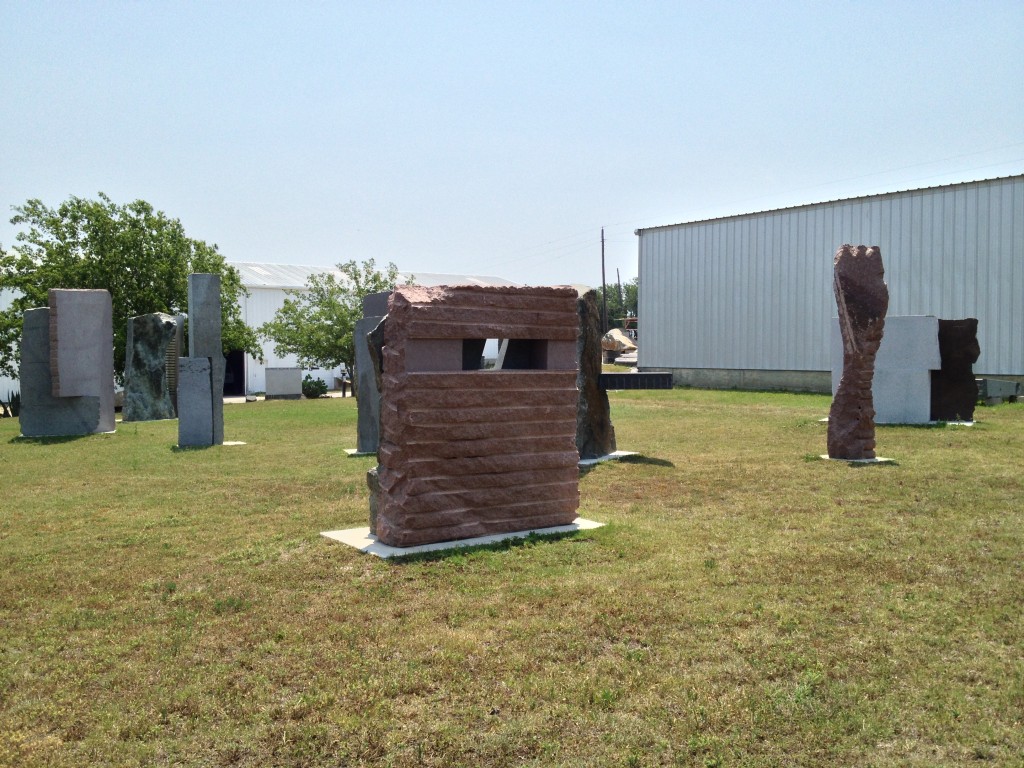
He says that you must have passion for what you do. He recalled a former student who was gifted but who said she couldn’t give up the comforts to which she was accustomed to be a serious artist. It was good that she realized that early on.
One of his dearest, oldest friends is an artist who did “1000 Portraits of Hope” of those displaced or affected by the Fukushima disaster in Japan. His name is Naoto Nakagawa. Jim says he feels like they are twin sons of different mothers.
He senses a diminution of his physical power but he is surprised things are going so well. He is 72 now but says that ever since his arthroscopic surgery he has the shoulders of a 50-year-old. He does regular rehab exercises. He has complete range of movement in his shoulders and only occasionally has pain. He spoke very highly of Dr. Nathan Breazeale at Austin Sports Medicine Clinic, who saw him through this process.
Jim feels that his good health can be attributed to attitude and gratitude. He says, “I don’t worry about what I don’t have and thank God for what I do have.” He is more interested in making sculptures than selling them. He works seven days a week and says, “I’m only interested in three things: eating, making love (when I was younger…sigh), and making art.”
We talked about spaces. I have always been fascinated by how human beings can create spaces and how those spaces affect our psyches. Jim loves internal spaces. He loved building forts as a kid. He is especially interested in stone and space. He likes to “make a space palpable.” He has much regard for Gaston Bachelard, whom he describes as “a typical French philosopher.” He was influenced by one of his works called, “The Poetics of Space.” You can find some of Jim’s own musings on space on the foundation website, huntingtonsculpture.org, under the section called “Writings.”
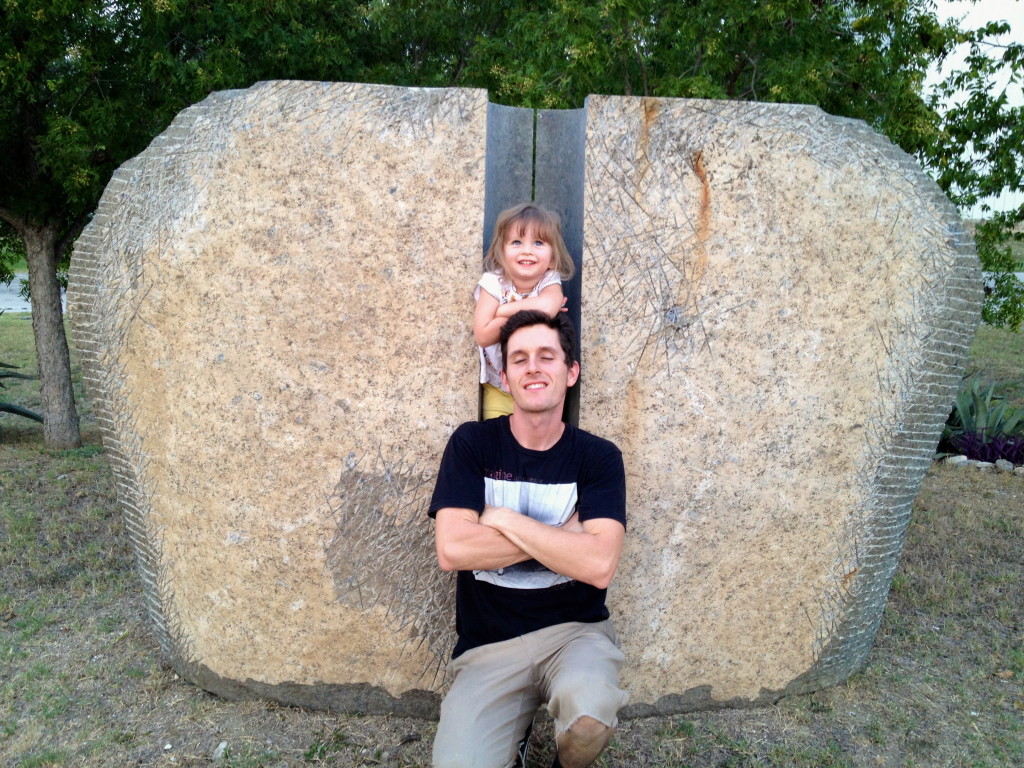
Kaliska Spencer enjoys one of the sculptures with her father, Jason. She says this piece reminds her of the giant stone that appears to walk away in the first selection of Walt Disney’s Fantasia, Toccata and Fugue in D Minor.
He very much appreciates the ineffable qualities of art. I recently sat on one of the pieces in the sculpture garden, which is open to the public, as my granddaughter ran around from one piece to the next, looking for hiding places. When you just drive or walk by and give the garden a quick glance, you see a lot of carved stone and formed metal. It wasn’t until I read his essay called, “Space The Final Frontier or the Third Element,” and watched the delight of a three-year-old that I really began to allow the various manifestations of the artist’s work to sink in.
About two weeks prior, we had visited the garden with some friends from out of town, while the kids ran around. That was when I first realized that I could have been taking my granddaughter to play in the garden all this time — and especially when it was cooler. One of our friends commented on her impression that the overall theme of the garden was repetitious. I think the implication was that it was therefore unimaginative. But after talking to Jim, reading his essay and seeing how children were so attracted to the pieces, I let go of my preconceptions of what art should be and simply allowed myself to be open the emotional and intellectual impressions that were evoked in me by the amazing variety of all the different shapes, colors, and textures.
I am reminded of how people are all so similar in appearance and yet the variety of detail makes everyone uniquely identifiable. Now I realize that I am going to have to figure out how I can get one of those pieces for myself. In the meantime, I plan to spend more time in the garden.
The Huntington Sculpture Foundation is open 24 hours a day, every day of the year by voluntary donations. On most days, the artist is working on the pad in front of the studio building.
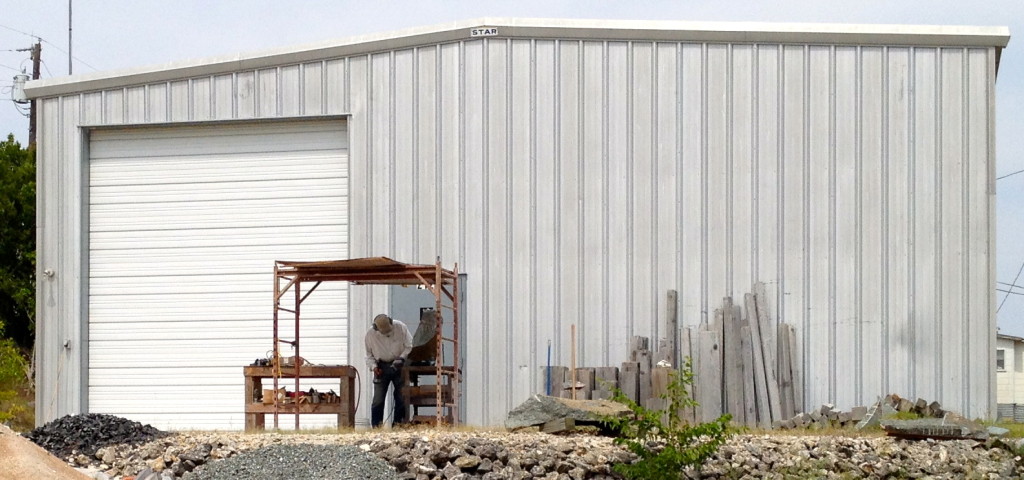
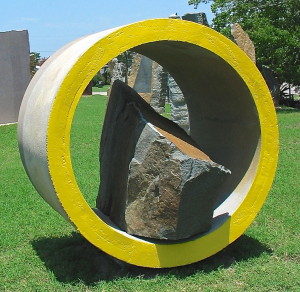 It is made of granite, concrete, and paint and measures 58” X 58” X 61”. Local artist Wells Mason helped him set the sculpture yesterday.
It is made of granite, concrete, and paint and measures 58” X 58” X 61”. Local artist Wells Mason helped him set the sculpture yesterday.
